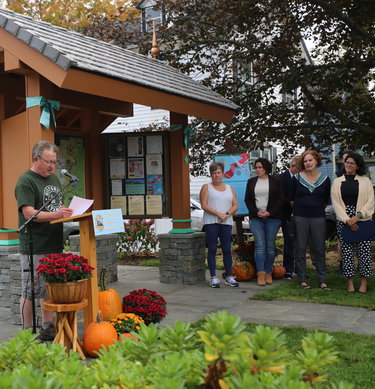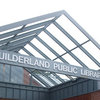‘Shining star’: Altamont celebrates itself as kiosk is unveiled
ALTAMONT — The village green was filled with people and buzzing with activity on Saturday afternoon under a warm September sun.
The Helderberg Kiwanis displayed their handmade bluebird houses, children had their faces painted and admired Altamont’s fire truck as families fed themselves from food trucks.
While Tom Walsh, the only person to hike the 358-mile Long Path through from both ends, spoke about his experience at the Altamont Free Library, the center of attention was the new kiosk across the green from the library.
The kiosk, built by Jake Rice, provides a new end point to the historic trail, which runs from the George Washington Bridge in Manhattan through the Helderbergs and now into Altamont. The kiosk was built with some of the funds from a $50,000 federal grant, secured through Albany County.
“Altamont is now a trail town,” said David Bourque, president of Historic Altamont Inc., which shepherded the project to completion.
“This community kiosk will be used to promote Altamont activities, nearby attractions, and local business,” he said, crediting his board and the volunteers who made it possible as well as Altamont artist Thom Breitenbach whose “vision for the kiosk clearly led the way.”
He went on to thank John Sands for “the beautiful landscaping”; Joe Burke, the library’s director, for “just too many things to list”; Tom Capuano and Kristin Casey, founders of Historic Altamont; Jeff Thomas for leasing the land; the Masonic Temple and the Altamont Reformed Church for their meeting spaces — and more.
“It takes a village,” said Bourque to sustained applause.
Congressman Paul Tonko, a Democrat representing the Capital Region, commended the group for “connecting history and heritage to the overall community.”
The Long Path, Tonko said, is about connecting communities. “And, wow, how could you have a better landing point than Altamont, which expresses community over and over again?” asked Tonko.
He went on, “My role here was voting for and advancing ARPA funds in Washington,” he said of the American Rescue Plan Act. “Economies around the world were taking a real hard hit from that once-in-a-century epidemic.”
The kiosk, he said, is typical of projects that spur recovery by allowing “for the economic multiplier to take hold,” bringing visitors to the village. “This will enable us to be part of a system from Manhattan to Altamont and then eventually into the Adirondacks that will connect people,” said Tonko, commending “local input, local design … proof positive that it’s working. We had the best comeback economically of any industrialized nation in the world post-COVID.”
Democratic Senator Patricia Fahy said she started her day in Albany, celebrating Mississippi Day, “talking about the trail of those who left Mississippi in the ’20s, ’30s, ’40s, and ’50s and settled in New York and settled here in Albany and how much it has enriched our community.”
She went on, “If we have learned nothing from COVID, it is that connectivity matters, being outdoors matters.”
Her favorite saying coming out of COVID, Fahy said, is, “Nature heals.”
She also gave “a shoutout to President Biden” for the grant money and noted she had been to many ribbon-cutting ceremonies for projects brought to fruition by ARPA funds.
Democratic Assemblywoman Gabriella Romero called Bourque and the Historic Altamont Board “the stewards of this village that keep the history and the uniqueness alive.”
She described a tour she took with the group where “almost every single street, it felt like it had a story.”
Romero concluded of the kiosk, “It is truly such a shining star in the village of Altamont, and many people will be able to see how incredible Altamont is.”
Republican Mark Grimm, who represents part of Guilderland in the Albany County Legislature, said, “We had a lot of money to give out on the ARPA funds: $60 million for the county. Now, the first $30 million went to losses that we sustained during COVID. The other $30 million was for grants like this.”
As part of distributing the $30 million to groups that applied, Grimm was appointed to a subcommittee on tourism and economic development, which, in addition to awarding $50,000 to Historic Altamont, also gave $50,000 to the Guilderland Chamber of Commerce.
“Guilderland comes first is always my position,” said Grimm, continuing, of Altamont, “Your village is special. You’ve got a lot of giddy-up.”
Grimm credited another Republican county legislator, Jeff Perlee, with promoting the kiosk. “This was really sort of his brainchild,” he said.
The kiosk, Perlee said, is “just the first step in a much larger effort to use public-access green space to protect Altamont’s natural and historic character and to make our village the hub of regional hiking and heritage conservation.”
Perlee also stressed, “In this current environment, I think it’s also important to point out that this is the result of bipartisan cooperation — Republicans, Democrats, independents, people with no affiliation whatsoever, working day in, day out to make something better for the community. And, in that way, I think Altamont also leads the way.”
Guilderland Councilwoman Amanda Beedle, a Democrat who has lived in Altamont since 1979, called it “a magical place which most people go into novels to find; we live and breathe it here every day.”
She, too, stressed the bipartisan support for the project.
“I love the fact that this was bipartisan because it just shows that, put all those differences aside, we can all come together to do really great things.”
She also stressed, “In this current climate,” the importance of “holding on to our history” as she noted Altamont’s Museum in the Streets, in which markers delineate places of historic interest in the village.
“You are truly angels here in our village,” Beedle told the Historic Altamont volunteers.
Village trustee Nicholas Fahrenkopf started his talk with a line that drew laughter: “We’ve now connected two of the most important municipalities in the Northeast: the city of New York and the village of Altamont. Now, I might be biased,” he conceded.
On a more serious note, he went on to talk about the kiosk as “a physical symbol of the extraordinary community passion that makes the village of Altamont so incredibly special.”
Fahrenkopf noted that the kiosk wasn’t funded by the village nor was it mandated by the village board.
“It was the volunteers of Historic Altamont who saw a need, secured the funding, sourced the design, and spent countless hours making this vision a reality,” he said.
He went on to describe Altamont as “a community where residents don’t have to wait for things to happen but step up to make them happen. The spirit of volunteerism and the commitment to local history and protecting our natural resources is our greatest strength.”
He noted that the project fulfills two recommendations from the village’s 2006 comprehensive plan: mapping and connecting recreational trails in and around the village and expanding the Long Path.
Fahrenkopf mentioned other Historic Altamont initiatives like the online Altamont StoryMap, the trail network being mapped around the village, and the Long Path art project that seeks to have a statue of a hiker placed near the kiosk.
“Each of those, like this kiosk, is powered by the passion of our neighbors. It’s the shared love of our village, this belief and collaboration, that gives Altamont its soul.”



